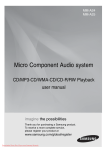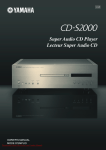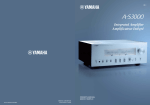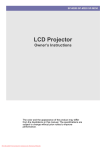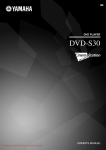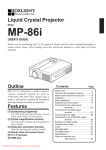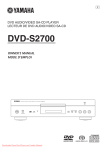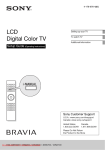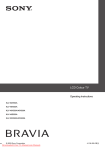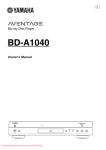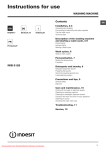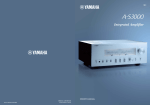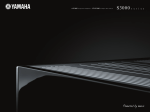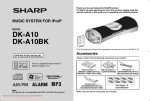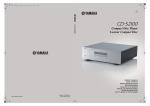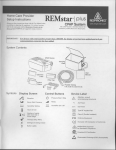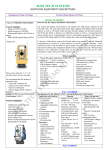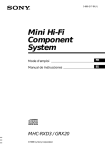Download Controls and functions - DVDPlayer
Transcript
U Compact Disc Player Lecteur Compact Disc OWNER’S MANUAL MODE D’EMPLOI Downloaded From DvDPlayer-Manual.com Yamaha Manuals A Living Tradition in Sound A piano comes into this world through the perfect synergy of advanced technical skill and artistry. Such a piano can create sound that truly reflects the player’s feelings. The final stage in piano production is called “voicing”. It is here that the instrument is given its soul. A highly skilled expert concentrates his mind and sensitivity on the sound of each key, finely adjusting the dynamic feel of the hammers, bringing the tone and vibrancy of all 88 keys together perfectly; a truly stunning achievement. It is a quality of sound that can only be determined by an astute, sensitive ear. We apply this very same concept to the manufacture of our audio products. The technician performs exhaustive listening tests and every component is considered, in order to finally achieve the ideal sound. Yamaha’s tradition of audio quality stretches back over 125 years, and continues to live on in all Yamaha products today. Downloaded From DvDPlayer-Manual.com Yamaha Manuals Excellence in Audio Achievement First HiFi System introduced in 1920 We introduced numerous HiFi components (turntables, FM/AM tuners, integrated amplifiers, preamplifiers, power amplifiers and speakers) in 1955 - 1965. Natural Sound Speaker Series introduced in 1967 NS-20 Monitor Speaker CA-1000 Integrated Amplifier Featuring A-Class operation, the CA-1000 set the standard for integrated amplifiers. NS-690 Natural Sound Speaker NS-1000M Monitor Speaker A truly legendary speaker still revered by HiFi enthusiasts. B-1 Power Amplifier An innovative power amp that used vertical FETs in all stages. C-2 Control Amplifier Received top prize at the Milan International Music and HiFi Show. NS-10M Studio Monitor Speaker Became of the most popular studio monitors in the world. A-1 Integrated Amplifier PX-2 Turntable Yamaha’s first straight arm turntable. B-6 Power Amplifier Pyramid-shaped power amplifier. GT-2000/L Turntable First CD Player (CD-1) introduced in 1983 B-2x Power Amplifier MX-10000 Power Amplifier and CX-10000 Control Amplifier Redefined the capabilities of separate components. AX-1 Integrated Amplifier GT-CD1 CD Player MX-1 Power Amplifier and CX-1 Preamplifier Soavo-1 and Soavo-2 Natural Sound Speaker Systems NP-S2000 Network Player Downloaded From DvDPlayer-Manual.com Yamaha Manuals English A-S2000 Stereo Amplifier and CD-S2000 Super Audio CD Player ◆ Full-stage balanced signal transmission beginning with the DAC achieves the ultimate in CD reproduction ◆ Independent power supplies with digital and analog completely separated ◆ Exclusive Yamaha loading mechanism and high precision CD drive ◆ Left-right symmetrical design with rigid, stable construction ◆ Pure Direct ◆ Super sound from Super Audio CDs ◆ Heavy feet with newly-developed antivibration spikes ◆ DSD playback via 192 kHz, 24-bit USB DAC ■ Supplied accessories Please check that you have received all of the following parts. • Power cable • Remote control • Batteries (AAA, R03, UM-4) (×2) • Stereo pin cable • SAFETY BROCHURE Contents Controls and functions.......................................................................................................................................... 6 Connections.......................................................................................................................................................... 18 Playback of music files stored on a PC.............................................................................................................. 22 Specifications ....................................................................................................................................................... 26 Playable disc format............................................................................................................................................ 27 Troubleshooting................................................................................................................................................... 29 ■ About this manual • y indicates a tip for your operation. • The color of images in this manual may vary from the original. • Read the “SAFETY BROCHURE” before using this unit. Downloaded From DvDPlayer-Manual.com Yamaha Manuals 4 En CONTROLS AND FUNCTIONS Controls and functions In this chapter, you will learn the controls and functions of CD-S3000. Downloaded From DvDPlayer-Manual.com Yamaha Manuals 5 En Controls and functions ■ Front panel (pages 6 to 9) SA-CD HYBRID TRACK TOTAL REMAIN PROG SHUFFLE REP OFF S ALL A-B STANDBY/ON PURE DIRECT SOURCE LAYER LAYER SA-CD CD DISC SOURCE OPTICAL COAXIAL USB OFF 1 2 3 4 5 7 1 STANDBY/ON/OFF switch Turns on or off this unit. STANDBY/ON (upper position): In this position, you can select STANDBY or ON, using the p CD key on the remote control. OFF (lower position): The power of this unit is turned off. Notes • When you turn on this unit, it will take a few seconds before this unit can reproduce sound. • If this unit is not operated for 30 minutes with no audio signal detected, it goes to STANDBY mode (page 15). • If you disconnect the power cable from the AC outlet and connect it again when this unit is in STANDBY mode, the power of the unit is turned on (page 20). If the unit is not to be operated for a long time, set the STANDBY/ON/OFF switch to OFF. Downloaded From DvDPlayer-Manual.com Yamaha Manuals 6 En 8 6 2 STANDBY/ON indicator Lit brightly: Shows that the power of the unit is ON. In this condition, you can switch the unit to STANDBY mode using the p CD key on the remote control. Lit dimly: Shows that the unit is in STANDBY mode. In this condition, press the p CD key on the remote control to turn on the unit. Off: Shows that the power of the unit is OFF. In this condition, you can turn on the unit using the STANDBY/ON/OFF switch only. 5 SOURCE key Selects the audio source to be played back. Each time you press this key, the audio source is switched. (coaxial digital input) (optical digital input) y The audio source setting is retained even if you turn off this unit. 6 SOURCE indicators The indicator of the audio source selected with the SOURCE key lights. 7 LAYER key Switches the playback layer of a hybrid Super Audio CD between SA-CD and CD while playback is stopped (page 27). y This setting is retained even if you turn off this unit. Note When SA-CD layer is selected, audio signals are output only from the BALANCED OUT and ANALOG OUT jacks. 3 PURE DIRECT key Turns on the PURE DIRECT mode to improve audio quality. When this unit is in the PURE DIRECT mode: • No signal is output from the DIGITAL OUT (OPTICAL and COAXIAL) jacks on the rear panel (page 10). • The least indicators and messages appear on the front panel display. 8 LAYER indicators The indicator of the layer selected with the LAYER key lights. y • Press this key again to turn off the PURE DIRECT mode. • This setting is retained even if you turn off this unit. 4 PURE DIRECT indicator Lights when the PURE DIRECT mode is turned on. English Downloaded From DvDPlayer-Manual.com Yamaha Manuals 7 En Controls and functions ■ Front panel (pages 6 to 9) E F G H I J K SA-CD HYBRID TRACK TOTAL REMAIN PROG SHUFFLE REP OFF S ALL STANDBY/ON PURE DIRECT SOURCE LAYER LAYER SA-CD CD DISC SOURCE USB OPTICAL COAXIAL OFF 9 9 Disc tray Loads a disc. 0 A (Open/Close) key Opens or closes the disc tray. y The disc tray also closes automatically when you press: • the (Play) key on the front panel or on the remote control. • the front edge of the disc tray gently. • a numeric button on the remote control. (Skip/Search backward) key Press the key once to skip back to the beginning of the current track. Press it twice to skip to the beginning of the previous track. Press and hold it to search backward. (Skip/Search forward) key Press the key once to skip to the next track. Press and hold it to search forward. B (Play) key Starts playback. C (Pause) key Pauses playback. Press the playback. D Downloaded From DvDPlayer-Manual.com Yamaha Manuals 8 En 0 (Stop) key Stops playback. or key to resume F Display The brightness can be adjusted with the DIMMER key on the remote control (page 12). G (playback) / (pause) indicator Lights in the playback/pause mode. H Disc type indicator Indicates the type (SA-CD/CD/HYBRID) of the disc in the disc tray. I Time display mode indicator Indicates the time display mode of the display. Change the mode by pressing the DISPLAY key on the remote control (page 13). Elapsed time of the current track Remaining time of the current track A B C Total remaining time of the disc D E Remote control sensor Receives signals from the remote control. J Playback mode indicator Indicates the current playback mode. PROG: Program playback (page 14) SHUFFLE: Shuffle playback (page 13) REP OFF: Repeat playback off (page 12) REP S: Single repeat playback (page 12) REP ALL: All repeat playback (page 12) K Information display y The remote control transmits a directional infrared beam. Be sure to aim the remote control directly at the remote control sensor on the front panel of this unit during operation. 30 30 See page 28 for more information on MP3/WMA playback. Approximately 6 m (20 ft) English Downloaded From DvDPlayer-Manual.com Yamaha Manuals 9 En Controls and functions ■ Rear panel 1 2 3 USB BALANCED OUT ANALOG OUT BALANCED OUT SYSTEM CONNECTOR GND 1 2 5 OPTICAL COAXIAL DIGITAL IN OUT 3 - COLD AC IN 8 See page 18 for connection information. 1 BALANCED OUT jacks (male) 2 ANALOG OUT jacks 3 DIGITAL IN USB jack (Type B) 4 DIGITAL IN OPTICAL jack 5 DIGITAL IN COAXIAL jack 6 DIGITAL OUT OPTICAL jack 7 DIGITAL OUT COAXIAL jack Note While playing the Super Audio CD layer, the audio signals are output only from the BALANCED OUT and ANALOG OUT jacks. Downloaded 10From En DvDPlayer-Manual.com Yamaha Manuals 9 OPTIC DI REMOTE IN +HOT 4 0 8 SYSTEM CONNECTOR Use this connector to connect a product testing device for servicing. 9 REMOTE IN/OUT jacks Use these jacks to connect an external component for remote operation. For details on the connection, see page 21. 0 AC IN inlet Use this inlet to plug in the supplied power cable. See page 20 for connection information. 6 7 OPTICAL COAXIAL DIGITAL OUT A A Foot The feet of this unit include built-in spikes. Using the spikes can reduce the effect of vibrations on the set. When using the spikes, remove the transport tape, then remove the magnet foot by pulling it. Spike Transport tape Magnet foot Caution English When using the feet’s built-in spikes, the spikes may scratch the shelf or floor on which this unit is installed. Use the magnet feet or appropriate supports when placing this unit on expensive furniture, etc. y If this unit is unstable, you can adjust the foot height by rotating it. Downloaded From DvDPlayer-Manual.com Yamaha Manuals 11 En Controls and functions ■ Remote control 3 1 4 p AMP key Turns the Yamaha amplifier ON or switches it to STANDBY mode. 2 3 OPEN/CLOSE key Opens or closes the disc tray. AMP OPEN/CLOSE CD 4 DIMMER PURE DIRECT DISPLAY @ A 5 1 2 3 4 5 6 7 8 9 ENTER CLEAR Some Yamaha amplifiers cannot be controlled with the p AMP key of this remote control. 5 DIMMER key Selects the brightness level for the front panel display. Each time you press the DIMMER key, the brightness level changes in the following order: 6 0 Note Max (brightest) Level 3 (darkest) B Level 1 (default) Level 2 y This setting is retained even if you turn off this unit. REPEAT PROGRAM SHUFFLE 7 6 Numeric buttons Use to select a track directly. Note This operation is ineffective for MP3 or WMA discs. 8 7 REPEAT key Repeats playback of a single track or all tracks. Each time you press the REPEAT key during playback, the repeat playback mode changes as follows: SOURCE LAYER C 9 VOLUME D MUTE (repeat playback off): Repeat playback is cancelled. (single repeat playback): On reaching the end of the current track, playback repeats from the beginning of the current track. (all repeat playback): On reaching the end of the last track, playback repeats from the beginning of the first track. INPUT Note This operation is ineffective for MP3 or WMA discs. 1 Infrared signal transmitter Sends infrared signals to this unit. 2 p CD key Turns this unit ON or switches it to STANDBY mode. For details on STANDBY, see “Front panel” (page 6). Downloaded 12From En DvDPlayer-Manual.com Yamaha Manuals PROGRAM key Turns on or off the program playback mode. See “Program playback” (page 14). SHUFFLE key Plays tracks on the disc in random order (shuffle playback). Notes • This operation is ineffective for MP3 or WMA discs. • The shuffle playback mode is cancelled when playback is stopped or the disc is ejected. 8 y • Press this key again to turn off the PURE DIRECT mode. • This setting is retained even if you turn off this unit. A DISPLAY key Switches the time display. Each time you press the DISPLAY key during playback, the time display changes as follows: (Search backward) key (Search forward) key Searches tracks backward/forward. (Pause) key Pauses playback. Press the playback. or Elapsed time of the current track Remaining time of the current track key to resume (Play) key Starts playback. (Skip backward) key Press the key once to skip back to the beginning of the current track. Press it twice to skip to the beginning of the previous track. (Skip forward) key Press the key once to skip to the next track. (Stop) key Stops playback. 9 SOURCE key Selects the audio source to be played back. Each time you press this key, the audio source is switched. Total remaining time of the disc B ENTER key Confirms a track number entered when you are programming tracks. CLEAR key Erases the last programmed track when this unit is in the program editing mode. See “Program playback” (page 14). y To erase all programmed tracks, press the CLEAR key while programmed playback is stopped. C LAYER key Switches the playback layer of a hybrid Super Audio CD between SA-CD and CD while playback is stopped (page 27). y This setting is retained even if you turn off this unit. Note (coaxial digital input) (optical digital input) y The audio source setting is retained even if you turn off this unit. Downloaded From DvDPlayer-Manual.com Yamaha Manuals D Yamaha amplifier operation keys Operates the Yamaha amplifier. Refer to the owner’s manual of your amplifier for details. Note Some Yamaha amplifiers cannot be controlled with the keys of this remote control. English 0 PURE DIRECT key Turns on the PURE DIRECT mode to improve audio quality. When this unit is in the PURE DIRECT mode: • The PURE DIRECT indicator lights. • No signal is output from the DIGITAL OUT (OPTICAL and COAXIAL) jacks on the rear panel (page 10). • The least indicators and messages appear on the front panel display. When SA-CD layer is selected, audio signals are output only from the BALANCED OUT and ANALOG OUT jacks. See page 28 for more information on MP3/WMA playback. 13 En Controls and functions ■ Program playback In the program playback mode, you can play back tracks in a programmed sequence. Notes • This operation is ineffective for MP3 or WMA discs. • The programmed tracks are erased in the following cases: – when the disc is ejected – when this unit is turned off or goes to STANDBY mode – when an audio source other than the disc is selected – when the playback layer of a hybrid Super Audio CD is switched between SA-CD and CD 1 Press PROGRAM while playback is stopped. This unit is set to the program editing mode. 2 Select a track by using the numeric buttons and press ENTER. 3 Repeat step 2 to program the next track. You can program up to 24 tracks. 4 Press the p (Play) key. Playback starts from the beginning of the programmed sequence. ■ Setting the DPLL (Digital Phased Lock Loop) bandwidth The audio DAC (ES9018) of this unit employs DPLL to generate accurate clock signals synchronized with the clock of the input digital audio signal. The 7-step DPLL bandwidth setting gives the unit tolerance for fluctuation of the clock of the input digital signal and adjustment of the accuracy of the operating clock in the DAC. 1 Press SOURCE to select the audio source to be played back. The DPLL bandwidth can be set for each audio source, respectively. 2 Within 5 seconds after selecting the audio source, press ENTER. The unit enters the setting mode, and the DPLL bandwidth currently set appears on the information display. 3 Select the DPLL bandwidth using the (pause) key and the (stop) key. Each time the (pause) key is pressed, the bandwidth changes in the following order. If you press the (stop) key, it changes in reverse order. (default) Downloaded 14From En DvDPlayer-Manual.com Yamaha Manuals 4 Press ENTER. The setting value flashes for 3 seconds, then the unit resumes to normal mode. To cancel the setting, press CLEAR. Notes • As the DPLL bandwidth setting value approaches “Lowest,” the accuracy of the operating clock in the DAC improves, but the unit may be susceptible to a change in the clock of the external component. The sound from such a component may more easily skips. • As the DPLL bandwidth setting value approaches “Highest,” the accuracy of the operating clock in the DAC deteriorates, but the unit is far less susceptible to a change in the clock of the external component, and the sound from such a component hardly skips. ■ Setting the AUTO POWER STANDBY function The AUTO POWER STANDBY function can be set to ON or OFF. When set to ON, if the unit is not operated for 30 minutes with no audio signal detected, it automatically goes to STANDBY mode. When set to OFF, the unit does not go to STANDBY mode automatically. 1 Open the disc tray and remove any currentlyloaded disc from the unit. Skip step 1 to 3 if “NO DISC” appears on the information display. 2 Close the disc tray. 3 Press SOURCE to select “DISC” as the audio source. “NO DISC” appears on the information display. 4 Press and hold the (Stop) key or (Play) key on the front panel for about 2 seconds to switch the setting. (Stop) key: The AUTO POWER STANDBY function switches to ON, and “AutoSTBY ON” appears on the information display. (Play) key: The AUTO POWER STANDBY function switches to OFF, and “AutoSTBY OFF” appears on the information display. Notes • The default setting for the AUTO POWER STANDBY function is ON. • This setting is retained even if you turn off this unit. English Downloaded From DvDPlayer-Manual.com Yamaha Manuals 15 En Controls and functions ■ Installing batteries in the remote control 1 Remove the battery compartment cover. 2 Insert the two batteries (AAA, R03, UM-4) according to the polarity markings (+ and -) on the inside of the battery compartment. 1 2 3 Reinstall the battery compartment cover. 3 Downloaded 16From En DvDPlayer-Manual.com Yamaha Manuals Connections In this section, you will make connections between CD-S3000 and your amplifier. Downloaded From DvDPlayer-Manual.com Yamaha Manuals Connections USB BALANCED OUT ANALOG OUT BALANCED OUT SYSTEM CONNECTOR GND 1 2 COAXIAL REMOTE IN +HOT OPTICAL DIGITAL IN OUT 3 - COLD AC IN Stereo pin cable When the SA-CD layer is played, the audio signals are output only from the BALANCED OUT and ANALOG OUT jacks. XLR balanced cable If your amplifier is equipped with XLR balanced input jacks, we recommend balanced connection for optimum audio performance. Amplifier Downloaded 18From En DvDPlayer-Manual.com Yamaha Manuals USB UT BALANCED OUT OPTICAL COAXIAL DIGITAL IN OPTICAL COAXIAL DIGITAL OUT LINK CONTROL IN AC IN Coaxial digital cable Component equipped with a digital output (PCM) jack Optical digital cable Coaxial digital cable Optical digital cable USB cable (Type B) PC AV receiver equipped with a digital input jack Note Only PCM signals can be input to the DIGITAL IN (OPTICAL/COAXIAL) jacks of this unit. For details on the supported PCM signals, see page 26. English Downloaded From DvDPlayer-Manual.com Yamaha Manuals 19 En Connections ■ Connecting to the BALANCED OUT jacks Connect your amplifier with the XLR balanced input jacks. The pin assignments for these jacks are shown below. Refer to the owner’s manual supplied with your amplifier and verify that its XLR balanced input jacks are compatible with the pin assignments. ■ Connecting the power cable Plug the power cable into the AC IN inlet when all connections are complete, and then plug in the power cable to the AC outlet. USB OPTICAL COAXIAL OPTICAL DIGITAL IN DIGIT TE 1: ground 2: hot OUT AC IN 3: cold When connecting, be sure to match the pins and insert the connector of the “female” XLR balanced cable. When disconnecting, pull out the “female” XLR balanced cable while pressing down the latch lock on the plug. Rear panel of CD-S3000 Latch lock Supplied power cable “Female” XLR connector “Male” XLR connector to an AC outlet Downloaded 20From En DvDPlayer-Manual.com Yamaha Manuals ■ Operating this unit from another room If you connect an infrared receiver and transmitter to the REMOTE IN/OUT jacks of this unit, you can operate the unit and/or external component using the supplied remote control located in another room. Rear panel of CD-S3000 SYSTEM CONNECTOR When you have another Yamaha component supporting remote connection, as this unit does, an infrared transmitter is not necessary. You can transmit remote signals by connecting an infrared receiver and the REMOTE IN jack of the other component to the REMOTE IN/OUT jacks of this unit, using cables with monaural miniplugs. Up to three Yamaha components (including this unit) can be connected. Rear panel of CD-S3000 SYSTEM CONNECTOR REMOTE IN ■ Remote connection between Yamaha components OUT REMOTE IN OUT AC IN Infrared receiver Infrared transmitter AC IN Infrared receiver REMOTE IN OUT Remote control External component (e.g. Amplifier) Remote control Yamaha component (up to three components including this unit) English Downloaded From DvDPlayer-Manual.com Yamaha Manuals 21 En Playback of music files stored on a PC When a PC is connected to the USB jack of this unit, the unit functions as a USB DAC, enabling music files stored on the PC to be played via an amplifier connected to the unit. ■ Installing the dedicated driver Before connecting a PC to this unit, install the dedicated driver on the PC. 1 Rear panel of CD-S3000 Access the following URL, download the dedicated “Yamaha Steinberg USB Driver,” then extract and execute the file. Website for downloading the exclusive driver URL: http://download.yamaha.com/ USB BALANCED OUT OPTICAL COAXIAL DIGITAL IN 2 Install the downloaded “Yamaha Steinberg USB Driver” on the PC. For details, refer to the Installation Guide supplied with the downloaded driver. 3 When installation is complete, quit all running applications. 4 Set the audio output destination of the computer to “Yamaha CD Player.” USB cable (Type B) With Windows OS: Control Panel → Sound → [Playback] tab With Mac OS: System Preferences → Sound → [Output] tab PC The setting may vary, depending on the operating system. For details, consult the manufacturer of your PC. ■ Supported operating systems The USB connection with this unit is for PCs with the following operating systems: Windows: Windows Vista (SP2, 32bit/64bit)/ Windows 7 (32bit/64bit)/ Windows 8 (32bit/64bit) Mac: OS X 10.5.8/10.6.8/10.7.x/10.8.x Notes • Operations with other operating systems are not guaranteed. • Operations may be disabled even with the above-mentioned operating systems, depending on the configuration or environment of the PC. • Operations may not be executed correctly if the PC is connected to this unit before the driver is installed. Downloaded 22From En DvDPlayer-Manual.com Yamaha Manuals y Transmittable sampling frequencies are as follows: 44.1 kHz/48 kHz/88.2 kHz/96 kHz/176.4 kHz/192 kHz Notes • Operations may not be executed correctly if the PC is connected to this unit before the driver is installed. • When the driver is installed on a Windows XP computer, the operation speed of the computer may be reduced. In such a case, restart the computer. • The “Yamaha Steinberg USB Driver” is subject to change without prior notice. For details and the latest information, refer to the download page for the driver. ■ Playing back music files stored on the PC 1 Connect the PC to this unit, using a USB cable. 2 Turn on the PC. 3 Turn this unit on by pressing the STANDBY/ ON/OFF switch on the front panel. 4 Select “USB,” using the SOURCE key of this unit. 5 Set the audio output destination of the PC to “Yamaha CD Player.” ■ Adjusting the sound volume To obtain higher sound quality, set the sound volume at the PC to the maximum, and gradually increase the volume at the amplifier from the minimum to your desired level. Notes • Do not disconnect the USB cable, turn off the unit, or change the input with the SOURCE key while playback on a PC connected via the USB cable is in progress. Doing so may cause a malfunction. • To mute operation sounds of the PC during music playback, change the setting on the PC. • If music files cannot be played correctly, restart the computer and perform the mentioned procedure again. • The music files stored on a PC cannot be controlled from this unit or the remote control of this unit. Operate them on the PC. With Windows OS: Control Panel → Sound → [Playback] tab With Mac OS: System Preferences → Sound → [Output] tab The setting may vary, depending on the operating system. For details, consult the manufacturer of your PC. 6 Operate the PC to start playback of music files. When the music signal is fed from the PC to the unit, the sampling frequency of the file being played is indicated on the display of the unit. English Downloaded From DvDPlayer-Manual.com Yamaha Manuals 23 En Downloaded 24From En DvDPlayer-Manual.com Yamaha Manuals Specifications In this section, you will find technical specifications for CD-S3000. Downloaded From DvDPlayer-Manual.com Yamaha Manuals Specifications AUDIO SECTION GENERAL • Frequency Response (1 kHz, 0 dB) SA-CD ..................................................... 2 Hz to 50 kHz (–3 dB) CD ......................................................................... 2 Hz to 20 kHz • Power Supply [China, Korea, Asia, Australia, U.K. and Europe models] .......................................................... AC 220 – 240 V, 50/60 Hz [U.S.A, Canada and Taiwan models] .......................................................... AC 110 – 120 V, 50/60 Hz • Playback Frequency Range ........................................2 Hz to 96 kHz • Harmonic Distortion (1 kHz, 0 dB) SA-CD .................................................................... 0.002% or less CD .......................................................................... 0.002% or less • Power Consumption ................................................................ 30 W • Standby Power Consumption (reference data) ......................... 0.3 W • Signal to Noise Ratio (IHF-A Network) (1 kHz, 0 dB) SA-CD/CD ........................................................... 116 dB or more • Dimensions (W × H × D) ............................... 435 × 142 × 440 mm (17-1/8” × 5-5/8” × 17-3/8”) • Dynamic Range (1 kHz, 0 dB) SA-CD .................................................................. 110 dB or more CD ........................................................................ 100 dB or more • Weight .................................................................. 19.2 kg (42.3 lbs) • Output Level (1 kHz, 0 dB) SA-CD/CD .................................................................. 2.0 ± 0.3 V LASER DIODE PROPERTIES • Wavelength SA-CD ............................................................................... 655 nm CD ..................................................................................... 790 nm • Output Power SA-CD .................................................................. 1.89 mW (max) CD ........................................................................ 1.36 mW (max) INPUT/OUTPUT SECTION • Digital Input (DIGITAL IN) USB (Type B) × 1 ........................................ USB 2.0 compliant OPTICAL × 1 COAXIAL × 1 Support audio sample rate ......... 44.1/48/88.2/96/176.4/192 kHz Word depths ............................................................. 16 bit/24 bit • Digital Output (DIGITAL OUT) OPTICAL × 1 COAXIAL × 1 Support audio sample rate ......... 44.1/48/88.2/96/176.4/192 kHz Word depths ............................................................. 16 bit/24 bit • Audio Output ANALOG OUT ..................................... Unbalanced × 2 ch (L/R) BALANCED OUT .................................... Balanced × 2 ch (L/R) • Remote Input/Output REMOTE IN REMOTE OUT • System Connector SYSTEM CONNECTOR Downloaded 26From En DvDPlayer-Manual.com Yamaha Manuals * Specifications are subject to change without notice. Taking care of this unit Polish finish on the side panels Use of Yamaha Unicon cloth (sold separately) is recommended. For heavy dirt, use Yamaha Piano Unicon (sold separately). For puschasing, contact your nearest authorized Yamaha dealer or service center. Other finish When you wipe this unit, do not use chemical solvents (alcohol, thinner, etc.), which might damage the finish. Use a clean, dry cloth. For heavy dirt, dampen a soft cloth in detergent diluted with water, wring it out, and clean this unit with the cloth. Playable disc format ■ Supported disc types CD-R, CD-RW digital audio discs Super Audio CD Music CDs made by copying onto a CD-R or CD-RW (including MP3 or WMA format files). This unit is designed to play back compact discs bearing the marks shown below. Never attempt to load any other types of discs into this unit. This unit can also play back 8cm (3-inch) compact discs. Notes Audio format based upon the current CD standards but includes a greater amount of information that provides higher quality sound. There are three types of discs: single layer, dual layer and hybrid discs. The hybrid disc can be played on existing CD players as well as Super Audio CD players since it contains both standard audio CD and Super Audio CD information. • Be sure to use a CD-R or CD-RW disc made by a reliable manufacturer. • Be sure to use a CD-R or CD-RW disc which has at least one of the following phrases on the disc or disc case. – FOR CONSUMER – FOR CONSUMER USE – FOR MUSIC USE ONLY • Be sure to use a finalized CD-R or CD-RW disc. CD-TEXT discs Note This unit does not show text data on the front panel display. Super Audio CD disc type Dual layer disc Hybrid layer disc Single layer disc HD layer HD layer The discs recorded with text data such as album titles, track titles, and artist names. These discs can be played back with ordinary CD players. CD layer HD layer Note This unit does not show text data on the front panel display. Hybrid Super Audio CD disc 1 CD layer that plays on any CD player NOTE: This unit may not be able to play back some CD-RW discs or discs on which recording was not made correctly. High Density layer containing: 2 - High Quality DSD Stereo 3 - High Quality DSD Multi-channel Compact discs (digital audio) To prevent a malfunction of this unit: • Do not use any nonstandard shaped disc (heart, etc.) available in the market as it might damage this unit. • Do not use a disc with tape, seals, or paste on it. Such a disc may get stuck in this unit or cause damage to this unit. The most popular discs for commercially available audio CDs. English Downloaded From DvDPlayer-Manual.com Yamaha Manuals 27 En Playable disc format ■ About MP3 and WMA discs You can play back MP3 and WMA files recorded on a CD-R or CD-RW with similar uses as a music CD. MP3 MP3 (MPEG-1 Audio Layer-3) is a standard technology and format for compressing an audio sequence into a small-sized file. However, the original level of sound quality is preserved during playback. Notes • This unit plays back MP3 files in alphanumeric order. • Up to 648 folders and files (combined) and up to 299 folders are recognized; however, some folders and files may not be recognized depending on their directory structure. • Depending on recording conditions such as recording software settings, this unit may not be able to play back the disc or files in the order they were recorded. • This unit is compatible with a sampling frequency of 44.1 kHz. • This unit is compatible with a bitrate of 32, 40, 48, 56, 64, 80, 96, 112, 128, 160, 192, 224, 256, or 320 kbps. Variable bitrate is not supported. • The disc must be ISO9660 compatible. • The text data contained in the files are not displayed on this unit. WMA WMA (Windows Media Audio) is a Microsoft file format for encoding digital audio files similar to MP3 although WMA can compress files at a higher rate than MP3. ■ Handling compact discs • Always handle a disc with care so that its surface is not scratched. • Compact discs are rarely worn out during playback, but damage to the disc surface when the disc is being handled can adversely affect the disc playback. • Be sure to use a felt-tip pen or similar writing tool when writing on the label side of a disc. Do not use a ball-point pen, pencil, or other hard-tipped writing tools as these may damage the disc and may adversely affect the disc playback. • Do not warp discs. • When a disc is not currently being used, remove it from this unit and store it in an appropriate case. • When removing or storing a disc, be careful not to scratch the playing surface. • Compact discs are not affected by small particles of dust or fingerprints on their playing surface, but even so they must be kept clean. Wipe the disc surface with a clean, cry cloth. Do not wipe the disc surface with a circular motion; wipe it straight outward from the center. Notes • This unit plays back WMA files in alphanumeric order. • Up to 648 folders and files (combined) and up to 299 folders are recognized; however, some folders and files may not be recognized depending on their directory structure. • This unit is compatible with a sampling frequency of 44.1 kHz. • This unit is compatible with a bitrate of 48, 64, 80, 96, 128, 160, or 192 kbps. Variable bitrate is not supported. • The disc must be ISO9660 compatible. • Copyright-protected WMA files cannot be played back with this unit. • The text data contained in the files are not displayed on this unit. • Do not try to clean the disc surface with any type of disc cleaner, record spray, anti-static spray or liquid, or any other chemical-based liquid as such substances may irreparably damage the disc surface. • Do not expose discs to direct sunlight, high temperature, or high humidity for a long period of time as these conditions may warp or otherwise damage the disc. • To play back an 8-cm (3-inch) compact disc, place it in the inner recessed area of the disc tray. Do not put a normal 12-cm CD on top of an 8-cm CD. Downloaded 28From En DvDPlayer-Manual.com Yamaha Manuals Troubleshooting Refer to the chart below if this unit does not function properly. If the problem you are experiencing is not listed below or if the instructions below do not help, turn off this unit, disconnect the power cable, and contact the nearest authorized Yamaha dealer or service center. Problem Cause Remedy See page The unit does not switch ON when STANDBY/ON/OFF is pressed upward. The power cable is not connected nor completely connected. Securely connect the power cable. This unit automatically goes to STANDBY mode. The automatic standby function is activated. If the unit is not operated for 30 minutes with no audio signal detected, it automatically goes to STANDBY mode. 6 The disc tray does not close completely. A foreign object is obstructing the tray. Carefully check the disc tray and remove the foreign object. — Playback does not start. The disc is damaged. Check the disc carefully; replace it if necessary. — There is moisture on the laser pickup. Wait 20 to 30 minutes after switching the unit ON before trying to play back a disc. — The disc is loaded upside down. Reload the disc with the label side up. — The disc is dirty. Clean the disc. 28 The MP3 or WMA formats are not compatible with this unit. Replace the disc with a correctly recorded disc playable with this unit. 28 The CD-RW (ReWritable) disc is not recorded correctly. Replace the disc with a correctly recorded disc playable with this unit. 27 The disc is a non-standard disc not playable with this unit. Replace the disc with a correctly recorded disc playable with this unit. 27 Playback is delayed, or begins at the wrong place. The disc may be scratched or damaged. Check the disc carefully; replace it if necessary. No sound. Improper output cable connections. Connect the cables properly. If the problem persists, the cables may be defective. 18 Improper amplifier operation. Set the amplifier controls to the correct input selection. — The unit is in PURE DIRECT mode. Turn off PURE DIRECT mode. 7 The Super Audio CD layer is being played. Change the layer for playback. This unit is being subjected to vibrations or impacts. Relocate this unit. The disc is dirty. Clean the disc. 28 The clock of the playback audio signal is fluctuated. Change the DPLL bandwidth of the audio DAC (ES9018). 14 Improper cable connections. Securely connect the audio cables. If the problem persists, the cables may be defective. 18 No playback sound from the component connected to the digital input jacks. Sound “skips.” Sound “hums.” 20 28 7 — English Downloaded From DvDPlayer-Manual.com Yamaha Manuals 29 En Troubleshooting Problem Cause Remedy See page Noise from a nearby tuner. The tuner is too close to this unit. Move the tuner and this unit farther apart. Noise from inside of the disc tray. The disc may be warped. Replace the disc. No sound from the component connected to the DIGITAL IN (OPTICAL or COAXIAL) jack. The output audio source setting on the connected component is not “PCM.” Only PCM audio sources can be played via the DIGITAL IN (OPTICAL/COAXIAL) jacks of this unit. Set the output audio source of the connected component to “PCM.” — The remote control does not work. The batteries of the remote control are too weak. Replace the batteries with new ones. 16 Remote control is too far away or tilted too much. Use within 6 m and 60° radius. Direct sunlight or lighting (of an inverter type fluorescent lamp etc.) is striking the remote control sensor of this unit. Reposition this unit. — 28 9 9 ■ On USB connection Problem The connected PC does not recognize this unit. Noisy playback. Music files cannot be played. Cause Remedy See page The operating system of the PC is not supported. Use a PC with an operation-guaranteed operating system. 22 Improper USB cable connection Connect the USB cable properly. The output of the PC or application is muted. Cancel the sound muting of the PC or application. — Another application is launched on the PC while a music file is being played. If another application is launched while a music file is being played, sound may be momentarily lost or noise may be generated. Do not launch other applications during playback. — The music data are not properly reproduced, because this unit is connected to the PC or the input of this unit is switched to “USB” while the music application is running on the PC. Connect this unit to the PC and set the input of the unit to “USB” in advance. Then launch the music application and start playback. The dedicated “Yamaha Steinberg USB Driver” has not been installed correctly. Install the “Yamaha Steinberg USB Driver” again, following the correct procedure. Downloaded 30From En DvDPlayer-Manual.com Yamaha Manuals 19, 22 23 22 ■ Messages on the information display Message Status NO DISC No disc is set on the disc tray. Check Cable The dedicated “Yamaha Steinberg USB Driver” has not been installed correctly. Or, the audio output of the computer has not been set to “Yamaha CD Player.” Check PC The audio signal from the computer cannot be recognized. Fs: ----kHz No audio signal is recognized. English Downloaded From DvDPlayer-Manual.com Yamaha Manuals 31 En Faire vivre la tradition du son Un piano vient au monde grâce à la synergie parfaite entre une expertise technique avancée et des talents artistiques. Un tel piano peut créer un son qui reflète vraiment les sentiments de l’interprète. L’étape finale de la production d’un piano est appelée « harmonisation ». C’est à ce moment-là que l’on donne son âme à l’instrument. Un expert hautement qualifié concentre son esprit et sa sensibilité sur le son de chaque touche, en ajustant avec finesse la sensation dynamique des marteaux et en harmonisant parfaitement la tonalité et la vibration de l’ensemble des 88 touches. C’est une réalisation vraiment exceptionnelle. Seule une oreille sensible et fine peut déterminer une telle qualité sonore. Nous appliquons ce même concept à la fabrication de nos produits audio. Le technicien effectue des tests d’écoute approfondis et chaque composant est étudié avant d’obtenir finalement le son idéal. La tradition de la qualité audio de Yamaha remonte à plus de 125 ans et est toujours présente dans l’ensemble des produits Yamaha actuels. Downloaded From DvDPlayer-Manual.com Yamaha Manuals L’excellence dans l’accomplissement audio Premier Système Hi-Fi introduit en 1920 Nous avons introduit de nombreux composants Hi-Fi (tourne-disques, tuners FM/AM, amplificateurs intégrés, préamplis, amplificateurs de puissance et enceintes) en 1955 – 1965. Commercialisation de la série d’enceintes Natural Sound en 1967 Enceinte de contrôle NS-20 Amplificateur intégré CA-1000 Faisant partie des appareils de Classe A, le CA-1000 est devenu la norme pour les amplificateurs intégrés. Enceinte Natural Sound NS-690 Enceinte de contrôle NS-1000M Une enceinte véritablement légendaire, toujours vénérée par les passionnés de Hi-Fi. Amplificateur de puissance B-1 Un ampli innovant utilisant des transistors FET à tous les étages. Amplificateur de commande C-2 A reçu le premier prix au Salon International de la Musique et de la Hi-Fi de Milan. Enceinte de contrôle pour studio NS-10M Devenue l’une des enceintes de studio les plus populaires au monde. Amplificateur intégré A-1 Tourne-disque PX-2 Premier tourne-disque à bras droit de Yamaha. Amplificateur de puissance B-6 Amplificateur de puissance pyramidal. Tourne-disque GT-2000/L Premier lecteur de CD (CD-1) commercialisé en 1983 Amplificateur de puissance B-2x Amplificateur de puissance MX-10000 et Amplificateur de commande CX-10000 Ont redéfini les fonctionnalités des composants séparés. Amplificateur intégré AX-1 Lecteur de CD GT-CD1 Amplificateur de puissance MX-1 et préamplificateur CX-1 Lecteur réseau NP-S2000 Downloaded From DvDPlayer-Manual.com Yamaha Manuals Français Systèmes d’enceintes Soavo-1 et Soavo-2 Natural Sound Amplificateur stéréo A-S2000 et lecteur de CD Super Audio CD-S2000 ◆ Transmission symétrique du signal sur tous les étages à partir du convertisseur N/A pour une reproduction exceptionnelle des CD ◆ Sources d’alimentation indépendantes avec numérique et analogique complètement séparés ◆ Mécanisme de chargement exclusif de Yamaha et lecteur de CD haute précision ◆ Conception symétrique gauche-droite avec construction rigide et stable ◆ Son direct pur ◆ Son des CD Super Audio extraordinaire ◆ Pieds robustes dotés de nouvelles pointes antivibratoires ◆ Lecture DSD via un convertisseur N/A USB 192 kHz, 24 bits ■ Accessoires fournis Veuillez vous assurer que tous les articles suivants vous ont bien été fournis. • Câble d’alimentation • Boîtier de télécommande • Piles (AAA, R03, UM-4) (×2) • Câble stéréo à fiche cinch • BROCHURE SUR LA SÉCURITÉ Table des matières Commandes et fonctions....................................................................................................................................... 6 Raccordements .................................................................................................................................................... 18 Lecture des fichiers musicaux stockés sur un PC ............................................................................................ 22 Caractéristiques techniques ............................................................................................................................... 26 Formats de disque lisibles................................................................................................................................... 27 Guide de dépannage ............................................................................................................................................ 29 ■ À propos de ce manuel • Le symbole y appelle votre attention sur un conseil d’utilisation. • La couleur des images dans ce manuel peut être différente de l’original. • Avant d’utiliser cet appareil, veuillez lire la « BROCHURE SUR LA SÉCURITÉ ». Downloaded From DvDPlayer-Manual.com Yamaha Manuals 4 Fr COMMANDES ET FONCTIONS Commandes et fonctions Ce chapitre décrit les commandes et fonctions du CD-S3000. Downloaded From DvDPlayer-Manual.com Yamaha Manuals 5 Fr Commandes et fonctions ■ Panneau avant (pages 6 à 9) SA-CD HYBRID TRACK TOTAL REMAIN PROG SHUFFLE REP OFF S ALL A-B STANDBY/ON PURE DIRECT SOURCE LAYER LAYER SA-CD CD DISC SOURCE OPTICAL COAXIAL USB OFF 1 2 3 4 5 7 1 Commutateur STANDBY/ON/OFF Met l’appareil sous tension ou hors tension. STANDBY/ON (position supérieure) : Dans cette position, vous pouvez sélectionner STANDBY ou ON, à l’aide de la touche p CD du boîtier de télécommande. OFF (position inférieure) : L’appareil est hors service. Remarques • Lorsque vous mettez l’appareil sous tension, celui-ci met quelques secondes à reproduire le son. • Si cet appareil n’est pas utilisé pendant 30 minutes sans signal audio détecté, il passe en mode STANDBY (page 15). • Si vous débranchez le câble d’alimentation secteur de la prise secteur et le rebranchez lorsque cet appareil est en mode STANDBY, l’appareil est mis sous tension (page 20). Si l’appareil n’est pas utilisé pendant une période prolongée, réglez le commutateur STANDBY/ON/OFF sur OFF. Downloaded From DvDPlayer-Manual.com Yamaha Manuals 6 Fr 8 6 2 Témoin STANDBY/ON Fortement allumé : Indique que l’appareil est sous tension. Dans cette condition, vous pouvez mettre l’appareil en mode STANDBY à l’aide de la touche p CD du boîtier de télécommande. Faiblement allumé : Indique que l’appareil est en mode STANDBY. Dans cette condition, appuyez sur la touche p CD du boîtier de télécommande pour mettre l’appareil sous tension. Éteint : Indique que l’appareil est hors tension (OFF). Dans cette condition, vous pouvez mettre l’appareil sous tension à l’aide du commutateur STANDBY/ON/OFF uniquement. 5 Touche SOURCE Sélectionne la source audio à lire. À chaque pression de cette touche, la source audio change. (entrée numérique coaxiale) (entrée numérique optique) y Le réglage de la source audio est retenu en mémoire même à la mise hors tension de l’appareil. 6 Témoins SOURCE Le témoin de la source audio sélectionnée avec la touche SOURCE s’allume. 7 Touche LAYER Sélectionne la couche de lecture SA-CD ou CD d’un CD Super Audio hybride pendant l’arrêt de la lecture (page 27). y Ce réglage est retenu en mémoire même à la mise hors tension de l’appareil. Remarque Lorsque la couche SA-CD est sélectionnée, les signaux audio sont uniquement émis par les prises BALANCED OUT et ANALOG OUT. 3 Touche PURE DIRECT Met en service le mode PURE DIRECT pour améliorer la qualité du son. Lorsque cet appareil est en mode PURE DIRECT : • Aucun signal n’est émis par les prises DIGITAL OUT (OPTICAL et COAXIAL) du panneau arrière de l’appareil (page 10). • Les témoins et messages apparaissent sur l’afficheur du panneau avant. 8 Témoins LAYER Le témoin de la couche sélectionnée avec la touche LAYER s’allume. y • Appuyez une nouvelle fois sur cette touche pour mettre le mode PURE DIRECT hors service. • Ce réglage est retenu en mémoire même à la mise hors tension de l’appareil. Downloaded From DvDPlayer-Manual.com Yamaha Manuals Français 4 Témoin PURE DIRECT S’allume lorsque le mode PURE DIRECT est en service. 7 Fr Commandes et fonctions ■ Panneau avant (pages 6 à 9) E F G H I J K SA-CD HYBRID TRACK TOTAL REMAIN PROG SHUFFLE REP OFF S ALL STANDBY/ON PURE DIRECT SOURCE LAYER LAYER SA-CD CD DISC SOURCE USB OPTICAL COAXIAL OFF 9 9 Tiroir de disque Pour insérer un disque. 0 Touche (Ouverture/Fermeture) Cette touche ouvre ou ferme le tiroir de disque. y Le tiroir de disque se ferme automatiquement lorsque vous appuyez sur : • la touche (Lecture) du panneau avant ou du boîtier de télécommande. • le bord avant du tiroir de disque délicatement. • une touche numérique du boîtier de télécommande. A Touche (Saut/Recherche arrière) Appuyez une fois sur cette touche pour revenir au début de la plage actuelle. Appuyez deux fois sur cette touche pour passer au début de la plage précédente. Appuyez en continu sur celle-ci pour effectuer une recherche vers l’arrière. Downloaded From DvDPlayer-Manual.com Yamaha Manuals 8 Fr 0 Touche (Saut/Recherche avant) Appuyez une fois sur cette touche pour passer à la plage suivante. Appuyez en continu sur celle-ci pour effectuer une recherche vers l’avant. B Touche (Lecture) Démarre la lecture. C Touche (Pause) Met la lecture en pause. Appuyez sur la touche pour poursuivre la lecture. D Touche (Stop) Arrête la lecture. ou F Affichage Il est possible de régler la luminosité avec la touche DIMMER du boîtier de télécommande (page 12). G Témoin (Lecture) / (Pause) S’allume en mode de lecture/pause. H Témoin du type de disque Indique le type (SA-CD/CD/HYBRID) de disque se trouvant dans le tiroir. I Témoin du mode d’affichage du temps Indique le mode d’affichage du temps de l’affichage. Changez de mode en appuyant sur la touche DISPLAY du boîtier de télécommande (page 12). Temps écoulé de la plage actuelle Temps restant de la plage actuelle A B C D E Capteur de télécommande Il reçoit les signaux émis par le boîtier de télécommande. Temps restant total du disque J Témoin du mode de lecture Indique le mode de lecture actuel. PROG : lecture de programme (page 14) SHUFFLE : lecture aléatoire (page 12) REP OFF : annulation de la répétition (page 12) REP S : répétition d’une plage (page 12) REP ALL : répétition de toutes les plages (page 12) K Affichage des informations y Le boîtier de télécommande émet un faisceau infrarouge bidirectionnel. Veillez à le pointer directement sur le capteur de télécommande de l’appareil pour en assurer le fonctionnement. 30 30 Voir page 28 pour un complément d’informations sur la lecture de MP3/WMA. Environ 6 m Français Downloaded From DvDPlayer-Manual.com Yamaha Manuals 9 Fr Commandes et fonctions ■ Panneau arrière 1 2 3 USB BALANCED OUT ANALOG OUT BALANCED OUT SYSTEM CONNECTOR GND 1 2 5 OPTICAL COAXIAL DIGITAL IN OUT 3 - COLD AC IN 8 Voir page 18 en ce qui concerne les raccordements. 1 Prises BALANCED OUT (mâles) 2 Prises ANALOG OUT 3 Prise DIGITAL IN USB (type B) 4 Prise DIGITAL IN OPTICAL 5 Prise DIGITAL IN COAXIAL 6 Prise DIGITAL OUT OPTICAL 7 Prise DIGITAL OUT COAXIAL Remarque Pendant la lecture de la couche du CD Super Audio, les signaux audio sont émis uniquement par les prises BALANCED OUT et ANALOG OUT. Downloaded 10From Fr DvDPlayer-Manual.com Yamaha Manuals 9 OPTIC DI REMOTE IN +HOT 4 0 8 SYSTEM CONNECTOR Utilisez ce connecteur pour brancher un dispositif de test de produits pour l’entretien. 9 Prises REMOTE IN/OUT Utilisez ces prises afin de raccorder un composant externe pour une utilisation à distance. Pour plus de détails sur le raccordement, voir page 21. 0 Prise AC IN Utilisez cette prise pour brancher le câble d’alimentation secteur fourni. Voir page 20 en ce qui concerne les raccordements. 6 7 OPTICAL COAXIAL DIGITAL OUT A A Pied Les pieds de cet appareil sont pourvus de crampons. Utilisez ces crampons pour réduire l’effet des vibrations sur l’appareil. Lorsque vous utilisez les crampons, retirez la bande de transport, puis ôtez le pied magnétique en tirant sur celui-ci. Crampon Bande de transport Pied magnétique Avertissement Français Les crampons des pieds peuvent rayer l’étagère ou la surface où vous installez cet appareil lorsque vous les utilisez. Utilisez les pieds magnétiques ou des supports appropriés pour placer cet appareil sur des meubles de valeur, etc. y Si l’appareil n’est pas stable, vous pouvez ajuster la hauteur d’un pied en le tournant. Downloaded From DvDPlayer-Manual.com Yamaha Manuals 11 Fr Commandes et fonctions ■ Boîtier de télécommande 3 Touche OPEN/CLOSE Cette touche ouvre ou ferme le tiroir de disque. 1 4 Touche p AMP Met l’amplificateur Yamaha sous tension ou le bascule en mode STANDBY. 2 3 AMP OPEN/CLOSE CD 4 Remarque DIMMER PURE DIRECT DISPLAY @ A 5 1 2 3 4 5 6 7 8 9 5 Touche DIMMER Sélectionne le niveau de luminosité de l’afficheur du panneau avant. Chaque fois que vous appuyez sur la touche DIMMER, le niveau de luminosité change de la façon suivante : 6 0 ENTER CLEAR Certains amplificateurs Yamaha ne peuvent pas être commandés par la touche p AMP de ce boîtier de télécommande. Max (luminosité maximale) B REPEAT PROGRAM SHUFFLE Level 3 (luminosité minimale) Level 1 (luminosité par défaut) Level 2 y 7 Ce réglage est retenu en mémoire même à la mise hors tension de l’appareil. 6 Pavé numérique Sert à sélectionner directement une plage. 8 Remarque Ceci n’est pas possible pour les disques MP3 ou WMA. SOURCE LAYER C 9 7 Touche REPEAT Répète une plage ou toutes les plages. À chaque pression du doigt sur la touche REPEAT pendant la lecture, le mode de répétition change de la façon suivante : (annulation de la répétition) : la lecture répétée est annulée. VOLUME D (répétition d’une plage) : à la fin de la plage actuelle, la lecture reprend au début de cette plage. MUTE INPUT (répétition de toutes les plages) : à la fin de la dernière plage, la lecture reprend au début de la première plage. Remarque 1 Émetteur de signal infrarouge Envoie les signaux infrarouges à cet appareil. 2 Touche p CD Met cet appareil sous tension ou le bascule en mode STANDBY. Pour plus de détails sur le mode STANDBY, voir « Panneau avant » (page 6). Downloaded 12From Fr DvDPlayer-Manual.com Yamaha Manuals Ceci n’est pas possible pour les disques MP3 ou WMA. Touche PROGRAM Met en ou hors service le mode de lecture de programme. Voir « Lecture de programme » (page 14). Touche SHUFFLE Effectue une lecture du disque dans un ordre aléatoire (lecture aléatoire). Remarques • Ceci n’est pas possible pour les disques MP3 ou WMA. • Le mode de lecture aléatoire est annulé lorsque la lecture est arrêtée ou le disque éjecté. A Touche DISPLAY Change l’affichage du temps. À chaque pression du doigt sur la touche DISPLAY pendant la lecture, l’affichage du temps change de la façon suivante : 8 Touche (Recherche arrière) Touche (Recherche avant) Recherche des plages vers l’arrière/l’avant. Touche (Pause) Met la lecture en pause. Appuyez sur la touche pour poursuivre la lecture. Temps écoulé de la plage actuelle Temps restant de la plage actuelle ou Touche (Lecture) Démarre la lecture. Touche (Saut arrière) Appuyez une fois sur cette touche pour revenir au début de la plage actuelle. Appuyez deux fois sur cette touche pour passer au début de la plage précédente. Touche (Saut avant) Appuyez une fois sur cette touche pour passer à la plage suivante. Touche (Stop) Arrête la lecture. 9 Touche SOURCE Sélectionne la source audio à lire. À chaque pression de cette touche, la source audio change. Temps restant total du disque B Touche ENTER Valide un numéro de plage saisi lors de la programmation de plages. Touche CLEAR Efface la dernière plage programmée lorsque l’appareil est en mode de programmation. Voir « Lecture de programme » (page 14). y Pour effacer toutes les plages programmées, appuyez sur la touche CLEAR lorsque la lecture programmée est arrêtée. C Touche LAYER Sélectionne la couche de lecture SA-CD ou CD d’un CD Super Audio hybride pendant l’arrêt de la lecture (page 27). y Ce réglage est retenu en mémoire même à la mise hors tension de l’appareil. (entrée numérique coaxiale) y (entrée numérique optique) Le réglage de la source audio est retenu en mémoire même à la mise hors tension de l’appareil. Lorsque la couche SA-CD est sélectionnée, les signaux audio sont uniquement émis par les prises BALANCED OUT et ANALOG OUT. D Touches de commande de l’amplificateur Yamaha Commandent l’amplificateur Yamaha. Reportez-vous au mode d’emploi de l’amplificateur pour le détail. Remarque Certains amplificateurs Yamaha ne peuvent pas être commandés par les touches de ce boîtier de télécommande. Voir page 28 pour un complément d’informations sur la lecture de MP3/WMA. • Appuyez une nouvelle fois sur cette touche pour mettre le mode PURE DIRECT hors service. • Ce réglage est retenu en mémoire même à la mise hors tension de l’appareil. Downloaded From DvDPlayer-Manual.com Yamaha Manuals 13 Fr Français 0 Touche PURE DIRECT Met en service le mode PURE DIRECT pour améliorer la qualité du son. Lorsque cet appareil est en mode PURE DIRECT : • Le témoin PURE DIRECT s’allume. • Aucun signal n’est émis par les prises DIGITAL OUT (OPTICAL et COAXIAL) du panneau arrière de l’appareil (page 10). • Les témoins et messages apparaissent sur l’afficheur du panneau avant. y Remarque Commandes et fonctions ■ Lecture de programme En mode de lecture de programme, vous pouvez lire les plages dans l’ordre de votre programmation. Remarques • Ceci n’est pas possible pour les disques MP3 ou WMA. • Les plages programmées sont effacées dans les cas suivants : – lorsque le disque est éjecté – lorsque cet appareil est mis hors tension ou passe en mode STANDBY – lorsqu’une source audio autre que le disque est sélectionnée – lorsque la couche de lecture d’un CD Super Audio hybride commute entre SA-CD et CD 1 Appuyez sur PROGRAM pendant l’arrêt de la lecture. Cet appareil est mis en mode de programmation. 2 Sélectionnez une plage à l’aide du pavé numérique et appuyez sur ENTER. 3 Répétez l’étape 2 pour programmer la plage suivante. Vous pouvez programmer en tout 24 plages. 4 Appuyez sur la touche p (Lecture). La lecture commence par la première des plages programmées. ■ Réglage de la bande passante DPLL (Digital Phased Lock Loop) Le convertisseur N/A audio (ES9018) de cet appareil emploie le DPLL pour générer des signaux d’horloge précis synchronisés avec l’horloge du signal audio numérique d’entrée. Le réglage de la bande passante DPLL en 7 étapes indique à l’appareil la tolérance de la fluctuation de l’horloge du signal d’entrée numérique et le réglage de la précision de l’horloge de fonctionnement dans le convertisseur N/A. 1 Appuyez sur SOURCE pour sélectionner la source audio que vous souhaitez lire. Il est possible de régler la largeur de bande DPLL respectivement pour chaque source audio. 2 Dans les 5 secondes qui suivent la sélection de la source audio, appuyez sur ENTER. L’appareil entre en mode de réglage, et la largeur de bande DPLL actuellement sélectionnée apparaît sur l’affichage des informations. 3 Sélectionnez la bande passante DPLL à l’aide de la touche (Pause) et de la touche (Stop). À chaque pression sur la touche (Pause), la bande passante varie dans l’ordre suivant. Si vous appuyez sur la touche (Stop), elle varie dans l’ordre inverse. (par défaut) Downloaded 14From Fr DvDPlayer-Manual.com Yamaha Manuals 4 Appuyez sur ENTER. La valeur de réglage clignote pendant 3 secondes, puis l’appareil revient au mode normal. Pour annuler le réglage, appuyez sur CLEAR. Remarques • Comme la valeur de réglage de la bande passante DPLL s’approche de « Lowest », la précision de l’horloge de fonctionnement dans le convertisseur N/A s’améliore, mais l’appareil est sensible aux changements dans l’horloge du composant extérieur. Il se peut que le son d’un tel composant saute plus facilement. • Comme la valeur de réglage de la bande passante DPLL s’approche de « Highest », la précision de l’horloge de fonctionnement dans le convertisseur N/A se détériore, mais l’appareil est bien moins sensible aux changements dans l’horloge du composant extérieur, et le son de ce composant saute à peine. ■ Réglage de la fonction AUTO POWER STANDBY La fonction AUTO POWER STANDBY peut être activée ou désactivée. Lorsqu’elle est activée, si l’appareil n’est pas utilisé pendant 30 minutes sans signal audio détecté, il passe automatiquement en mode STANDBY. Lorsqu’elle est désactivée, l’appareil ne passe pas automatiquement en mode STANDBY. 1 Ouvrez le tiroir de disque et retirez de l’appareil tous les disques qui y sont insérés. Sautez les étapes 1 à 3 si « NO DISC » apparaît sur l’affichage des informations. 2 Fermez le tiroir de disque. 3 Appuyez sur SOURCE pour sélectionner la source audio « DISC ». « NO DISC » apparaît sur l’affichage des informations. 4 Appuyez en continu sur la touche (Stop) ou sur la touche (Lecture) du panneau avant pendant environ 2 secondes pour changer de réglage. Touche (Stop) : La fonction AUTO POWER STANDBY s’active et « AutoSTBY ON » apparaît sur l’affichage des informations. Touche (Lecture) : La fonction AUTO POWER STANDBY se désactive et « AutoSTBY OFF » apparaît sur l’affichage des informations. Remarques • La fonction AUTO POWER STANDBY est activée par défaut. • Ce réglage est retenu en mémoire même à la mise hors tension de l’appareil. Français Downloaded From DvDPlayer-Manual.com Yamaha Manuals 15 Fr Commandes et fonctions ■ Mise en place des piles dans le boîtier de télécommande 1 Retirez le couvercle du logement des piles. 2 Insérez les deux piles (AAA, R03, UM-4) en suivant les repères de polarité (+ et -) à l’intérieur du logement des piles. 1 2 3 Replacez le couvercle du logement des piles. 3 Downloaded 16From Fr DvDPlayer-Manual.com Yamaha Manuals Raccordements Dans cette section, vous allez raccorder le CD-S3000 à votre amplificateur. Downloaded From DvDPlayer-Manual.com Yamaha Manuals Raccordements USB BALANCED OUT ANALOG OUT BALANCED OUT SYSTEM CONNECTOR GND 1 2 COAXIAL REMOTE IN +HOT OPTICAL DIGITAL IN OUT 3 - COLD AC IN Câble stéréo à fiche cinch Lorsque la couche SA-CD est lue, les signaux audio sont uniquement émis par les prises BALANCED OUT et ANALOG OUT. Câble symétrique XLR Si votre amplificateur est muni de prises d’entrée symétriques XLR, nous vous conseillons le raccordement symétrique pour obtenir le meilleur son possible. Amplificateur Downloaded 18From Fr DvDPlayer-Manual.com Yamaha Manuals USB UT BALANCED OUT OPTICAL COAXIAL DIGITAL IN OPTICAL COAXIAL DIGITAL OUT LINK CONTROL IN AC IN Câble coaxial numérique Composant équipé d’une prise de sortie numérique (PCM) Câble optique numérique Câble coaxial numérique Câble optique numérique Câble USB (type B) PC Récepteur AV doté d’une prise d’entrée numérique Remarque Seuls les signaux PCM peuvent être transmis aux prises DIGITAL IN (OPTICAL/COAXIAL) de cet appareil. Pour plus de détails sur les signaux PCM pris en charge, voir page 26. Français Downloaded From DvDPlayer-Manual.com Yamaha Manuals 19 Fr Raccordements ■ Raccordement aux prises BALANCED OUT Raccordez votre amplificateur aux prises d’entrée symétriques XLR. Les broches se répartissent de la façon suivante pour ces prises. Reportez-vous au mode d’emploi fourni avec votre amplificateur et vérifiez que les prises d’entrée symétriques XLR sont compatibles avec cette répartition des broches. ■ Raccordement du câble d’alimentation Branchez le câble d’alimentation secteur sur la prise AC IN lorsque tous les appareils ont été raccordés, puis branchez-le sur la prise secteur. USB OPTICAL COAXIAL OPTICAL DIGITAL IN DIGIT TE OUT 1 : masse 2 : chaud AC IN 3 : froid Lors du raccordement, veillez à bien aligner les broches et à insérer la fiche symétrique XLR « femelle ». Pour débrancher le câble à fiche « femelle » symétrique XLR, tirez sur la fiche tout en appuyant sur le taquet. Câble d’alimentation fourni Taquet Connecteur XLR « femelle » Panneau arrière du CD-S3000 Connecteur XLR « mâle » vers une prise secteur Downloaded 20From Fr DvDPlayer-Manual.com Yamaha Manuals ■ Fonctionnement de cet appareil dans une autre pièce ■ Connexion à distance entre les composants Yamaha Si vous branchez un récepteur et un émetteur infrarouge aux prises REMOTE IN/OUT de cet appareil, vous pouvez utiliser l’appareil et/ou le composant externe à l’aide du boîtier de télécommande fourni situé dans une autre pièce. Lorsque vous avez un autre composant Yamaha prenant en charge la connexion à distance, comme c’est le cas pour cet appareil, un émetteur infrarouge est inutile. Vous pouvez transmettre des signaux à distance en raccordant un récepteur infrarouge et la prise REMOTE IN de l’autre composant aux prises REMOTE IN/OUT de cet appareil, avec des câbles à mini-fiches mono. Il est possible de raccorder jusqu’à trois composants Yamaha (cet appareil compris). Panneau arrière du CD-S3000 Panneau arrière du CD-S3000 SYSTEM CONNECTOR SYSTEM CONNECTOR REMOTE IN OUT REMOTE IN OUT AC IN Récepteur infrarouge Émetteur infrarouge AC IN Récepteur infrarouge REMOTE IN OUT Boîtier de télécommande Composant externe (ex. : amplificateur) Boîtier de télécommande Composant Yamaha (jusqu’à trois composants, cet appareil compris) Français Downloaded From DvDPlayer-Manual.com Yamaha Manuals 21 Fr Lecture des fichiers musicaux stockés sur un PC Lorsqu’un PC est branché à la prise USB de cet appareil, ce dernier fonctionne comme un convertisseur N/A USB, ce qui permet aux fichiers musicaux stockés sur le PC d’être lus via un amplificateur raccordé à l’appareil. ■ Installation du pilote dédié Avant de relier un PC à cet appareil, installez le pilote dédié sur le PC. 1 Panneau arrière du CD-S3000 Accédez à l’URL suivante, téléchargez le pilote dédié « Yamaha Steinberg USB Driver », puis extrayez et exécutez le fichier. Site Web de téléchargement du pilote exclusif URL : http://download.yamaha.com/ USB BALANCED OUT OPTICAL COAXIAL DIGITAL IN 2 Installez le pilote « Yamaha Steinberg USB Driver » téléchargé sur le PC. Pour plus de détails, reportez-vous au Guide d’installation fourni avec le pilote téléchargé. 3 Une fois l’installation terminée, quittez toutes les applications en cours d’exécution. 4 Réglez la destination de sortie audio de l’ordinateur sur « Yamaha CD Player ». Câble USB (type B) Avec le système d’exploitation Windows : Panneau de configuration → Son → Onglet [Lecture] Avec le système d’exploitation Mac : Préférences Système → Son → Onglet [Sortie] PC Le réglage peut varier en fonction du système d’exploitation. Pour plus de détails, consultez le fabricant de votre PC. ■ Systèmes d’exploitation pris en charge La connexion USB avec cet appareil convient aux PC équipés des systèmes d’exploitation suivants : Windows :Windows Vista (SP2, 32 bits/64 bits)/ Windows 7 (32 bits/64 bits)/ Windows 8 (32 bits/64 bits) Mac : OS X 10.5.8/10.6.8/10.7/10.7.x/10.8.x y Les fréquences d’échantillonnage transmissibles sont les suivantes : 44,1 kHz/48 kHz/88,2 kHz/96 kHz/176,4 kHz/192 kHz Remarques Remarques • Le fonctionnement n’est pas garanti avec d’autres systèmes d’exploitation. • Selon la configuration ou l’environnement de l’ordinateur, il se peut que des opérations soient désactivées, même avec les systèmes d’exploitation susmentionnés. • Certaines opérations risquent de ne pas s’exécuter correctement si le PC est relié à cet appareil avant l’installation du pilote. Downloaded 22From Fr DvDPlayer-Manual.com Yamaha Manuals • Certaines opérations risquent de ne pas s’exécuter correctement si le PC est relié à cet appareil avant l’installation du pilote. • Si le pilote est installé sur un ordinateur Windows XP, la vitesse de fonctionnement de l’ordinateur risque d’être réduite. Dans ce cas, redémarrez l’ordinateur. • Le « Yamaha Steinberg USB Driver » peut être modifié sans avis préalable. Pour obtenir des détails et les dernières informations, reportez-vous à la page de téléchargement du pilote. ■ Lecture des fichiers musicaux stockés sur le PC 1 Reliez le PC à cet appareil à l’aide d’un câble USB. 2 Mettez le PC sous tension. 3 Mettez cet appareil sous tension en appuyant sur le commutateur STANDBY/ON/OFF du panneau avant. 4 Sélectionnez « USB » avec la touche SOURCE de cet appareil. 5 Réglez la destination de sortie audio du PC sur « Yamaha CD Player ». ■ Réglage du volume sonore Pour obtenir une meilleure qualité sonore, réglez le volume sonore du PC au maximum, puis augmentez progressivement le volume de l’amplificateur du minimum au niveau souhaité. Remarques • Ne débranchez pas le câble USB, mettez l’appareil hors tension ou changez d’entrée avec la touche SOURCE lorsque la lecture sur un PC relié par un câble USB est en cours. Cela pourrait entraîner un dysfonctionnement. • Pour désactiver les sons de fonctionnement de l’ordinateur pendant la lecture de musique, modifiez le réglage sur le PC. • S’il est impossible de lire correctement des fichiers musicaux, redémarrez l’ordinateur et recommencez la procédure mentionnée. • Il est impossible de commander les fichiers musicaux stockés sur un PC à partir de cet appareil ou du boîtier de télécommande de cet appareil. Commandez-les sur le PC. Avec le système d’exploitation Windows : Panneau de configuration → Son → Onglet [Lecture] Avec le système d’exploitation Mac : Préférences Système → Son → Onglet [Sortie] Le réglage peut varier en fonction du système d’exploitation. Pour plus de détails, consultez le fabricant de votre PC. 6 Mettez le PC en marche pour lancer la lecture des fichiers musicaux. Lorsque le signal de musique est émis du PC à l’appareil, la fréquence d’échantillonnage du fichier en cours de lecture est indiquée sur l’écran de l’appareil. Français Downloaded From DvDPlayer-Manual.com Yamaha Manuals 23 Fr Downloaded 24From Fr DvDPlayer-Manual.com Yamaha Manuals Caractéristiques techniques Dans cette section, vous trouverez les caractéristiques techniques du CD-S3000. Downloaded From DvDPlayer-Manual.com Yamaha Manuals Caractéristiques techniques SECTION AUDIO GÉNÉRALITÉS • Réponse en fréquence (1 kHz, 0 dB) SA-CD ....................................................... 2 Hz à 50 kHz (–3 dB) CD ............................................................................ 2 Hz à 20 kHz • Alimentation [Modèles pour la Chine, la Corée, l’Asie, l’Australie, le RoyaumeUni et l’Europe].................................220 – 240 V CA, 50/60 Hz [Modèles pour les États-Unis, le Canada et Taïwan] ...........................................................110 – 120 V CA, 50/60 Hz • Plage de fréquences de lecture ................................... 2 Hz à 96 kHz • Distorsion harmonique (1 kHz, 0 dB) SA-CD .............................................................. 0,002 % ou moins CD .................................................................... 0,002 % ou moins • Rapport signal/bruit (Réseau IHF-A) (1 kHz, 0 dB) SA-CD/CD ............................................................ 116 dB ou plus • Gamme dynamique (1kHz, 0 dB) SA-CD ................................................................... 110 dB ou plus CD ......................................................................... 100 dB ou plus • Niveau de sortie (1 kHz, 0 dB) SA-CD/CD .................................................................. 2,0 ± 0,3 V PROPRIÉTÉS DE LA DIODE LASER • Longueur d’ondes SA-CD ............................................................................... 655 nm CD ..................................................................................... 790 nm • Puissance de sortie SA-CD ................................................................. 1,89 mW (max.) CD ....................................................................... 1,36 mW (max.) SECTION ENTRÉE/SORTIE • Entrée numérique (DITIGAL IN) USB (Type B) × 1 ......................................... Conforme USB 2.0 OPTICAL × 1 COAXIAL × 1 Prise en charge du taux d’échantillonnage audio .................................................... 44,1/48/88,2/96/176,4/192 kHz Profondeurs de mot .................................................16 bits/24 bits • Sortie numérique (DITIGAL OUT) OPTICAL × 1 COAXIAL × 1 Prise en charge du taux d’échantillonnage audio .................................................... 44,1/48/88,2/96/176,4/192 kHz Profondeurs de mot .................................................16 bits/24 bits • Sortie audio ANALOG OUT...............................asymétrique × 2 canaux (G/D) BALANCED OUT........................... symétrique × 2 canaux (G/D) • Entrée/Sortie à distance REMOTE IN REMOTE OUT • Connecteur de système SYSTEM CONNECTOR Downloaded 26From Fr DvDPlayer-Manual.com Yamaha Manuals • Consommation.......................................................................... 30 W • Consommation en veille (données de référence)...................... 0,3 W • Dimensions (L × H × P) ................................. 435 × 142 × 440 mm • Poids ......................................................................................19,2 kg * Les caractéristiques techniques peuvent être modifiées sans avis préalable. Entretien de cet appareil Finition brillante sur les panneaux latéraux L’utilisation du chiffon Yamaha Unicon (disponible en option) est recommandée. Pour enlever les taches rebelles, utilisez le Yamaha Piano Unicon (disponible en option). Pour l’achat, contactez le revendeur ou le service après-vente agréé Yamaha le plus proche. Autre finition Pour essuyer cet appareil, n’utilisez pas de solvants chimiques (alcool, diluant, etc.) qui risqueraient d’endommager la finition. Utilisez un chiffon propre et sec. Pour enlever les taches rebelles, trempez un chiffon doux dans un mélange de détergent et d’eau et extrayez bien toute l’eau du chiffon avant de nettoyer l’appareil. Formats de disque lisibles ■ Types de disques pris en charge Disques audio numériques CD-R, CD-RW CD Super Audio CD de musique obtenus par copie sur un CD-R ou CDRW (fichiers de format MP3 ou WMA compris). Cet appareil peut lire les disques compacts portant les logos suivants. N’essayez jamais de mettre d’autres types de disques dans cet appareil. Cet appareil peut également lire les disques compacts de 8 cm. Remarques Il s’agit d’un format audio basé sur les normes CD actuelles mais contenant un grand nombre d’informations qui améliorent la qualité du son. Il existe trois types de disques : les disques à couche unique, les disques à double couche et les disques hybrides. Les disques hybrides peuvent être lus sur les lecteurs CD existants de même que sur les lecteurs de CD Super Audio, car ils contiennent des informations CD audio classiques et CD Super Audio. • Veillez à utiliser des CD-R ou CD-RW d’une marque fiable. • Veillez à utiliser des CD-R ou CD-RW sur lesquels au moins une des phrases suivantes est inscrite sur le disque ou le boîtier du disque. – FOR CONSUMER – FOR CONSUMER USE – FOR MUSIC USE ONLY • Veillez à utiliser des CD-R ou CD-RW finalisés. Disques CD-TEXT Remarque L’afficheur du panneau avant de cet appareil n’affiche pas de données alphabétiques. Type de disque CD Super Audio Disque à couche unique Couche HD Disque à double couche Couche HD Disque à couche hybride Couche CD Couche HD Disques enregistrés avec des données alphabétiques, telles que les titres d’album, les titres de plages et les noms d’artistes. Ces disques peuvent être lus par les lecteurs de CD ordinaires. Remarque L’afficheur du panneau avant de cet appareil n’affiche pas de données alphabétiques. Disque CD Super Audio hybride 1 Couche CD pouvant être lue sur n’importe quel lecteur CD Couche de haute densité contenant : 2 du son stéréo DSD de haute qualité 3 du son multicanaux DSD de haute qualité Disques compacts (audio numériques) Les disques audio les plus populaires en vente dans le commerce. REMARQUE : Cet appareil ne pourra pas lire les CD-RW ou disques qui n’ont pas été enregistrés convenablement. Pour éviter toute anomalie de fonctionnement : • N’utilisez pas un disque de forme inhabituelle (en forme de cœur, etc.), en vente dans le commerce, car il pourrait endommager cet appareil. • N’utilisez pas de disque ayant une étiquette, du ruban adhésif ou de la colle sur la surface. Le disque pourrait rester coincé dans l’appareil et l’endommager. Français Downloaded From DvDPlayer-Manual.com Yamaha Manuals 27 Fr Formats de disque lisibles ■ À propos des disques MP3 et WMA Vous pouvez lire les fichiers MP3 et WMA enregistrés sur un CD-R ou CD-RW de la même façon qu’un CD de musique. MP3 MP3 (MPEG-1 Audio Layer-3) est un format et une technologie standard destinés à comprimer les données audio de manière à réduire la taille des fichiers. Toutefois, le niveau original de qualité sonore est préservé lors de la lecture. Remarques • Ce appareil lit les fichiers MP3 dans l’ordre alphanumérique. • Un maximum de 648 dossiers et fichiers (combinés) et de 299 dossiers peuvent être reconnus ; toutefois, certains dossiers et fichiers peuvent ne pas être reconnus à cause de la structure de leur répertoire. • Selon les conditions d’enregistrement, par exemple les réglages utilisés lors de l’enregistrement, cet appareil peut être incapable de logiciel de lire les plages ou les fichiers du disque dans l’ordre où ils ont été enregistrées. • Cet appareil est compatible avec une fréquence d’échantillonnage de 44,1 kHz. • Cet appareil est compatible avec un débit binaire de 32, 40, 48, 56, 64, 80, 96, 112, 128, 160, 192, 224, 256 ou 320 kbps. Le débit binaire variable n’est pas pris en charge. • Le disque doit être compatible avec la norme ISO9660. • Les données alphabétiques contenues dans les fichiers ne sont pas affichées sur cet appareil. ■ Maniement des disques compacts • Maniez toujours un disque avec précaution de manière à ne pas rayer sa surface. • Les disques compacts ne s’usent pratiquement pas à la lecture, mais une surface endommagée par un mauvais traitement peut affecter la lecture. • Veuillez utiliser un crayon feutre ou un crayon similaire pour écrire sur la face étiquetée d’un disque. N’utilisez pas de stylo à bille, de crayon ni d’outils à extrémité dure, car ils peuvent endommager le disque et affecter la lecture. • Ne tordez pas les disques. • Lorsque vous n’utilisez pas un disque, retirez-le de l’appareil et rangez-le dans son boîtier. • Lorsque vous retirez ou rangez un disque, veillez à ne pas rayer la face gravée. • Les petites particules de poussière ou les traces de doigts sur la face gravée n’affectent pas les disques compacts, mais ils doivent malgré tout être maintenus propres. Essuyez la surface du disque avec un chiffon propre et sec. N’essuyez pas la surface du disque en un mouvement circulaire, mais en allant du centre vers la périphérie. WMA Le WMA (Windows Media Audio) est un format de fichier Microsoft utilisé pour le codage des fichiers audio numériques similaires au MP3 mais le WMA peut compresser les fichiers à un niveau plus élevé que le MP3. Remarques • Ce appareil lit les fichiers WMA dans l’ordre alphanumérique. • Un maximum de 648 dossiers et fichiers (combinés) et de 299 dossiers peuvent être reconnus ; toutefois, certains dossiers et fichiers peuvent ne pas être reconnus à cause de la structure de leur répertoire. • Cet appareil est compatible avec une fréquence d’échantillonnage de 44,1 kHz. • Cet appareil est compatible avec un débit binaire de 48, 64, 80, 96, 128, 160 ou 192 kbps. Le débit binaire variable n’est pas pris en charge. • Le disque doit être compatible avec la norme ISO9660. • Les fichiers WMA protégés contre la copie ne peuvent pas être lus sur cet appareil. • Les données alphabétiques contenues dans les fichiers ne sont pas affichées sur cet appareil. • N’essayez pas de nettoyer la surface du disque avec des produits de nettoyage de disques, des aérosols pour microsillons, des aérosols ou liquides antistatiques ou tout autre liquide à base chimique car ces substances peuvent endommager définitivement la surface du disque. • N’exposez pas les disques à la lumière directe du soleil, à une haute température ou à une haute humidité pendant longtemps car ils pourraient se déformer ou être endommagés. • Pour lire un disque compact de 8 cm, posez-le sur le cercle intérieur du tiroir de disque. Ne posez pas un CD normal de 12 cm sur un CD de 8 cm. Downloaded 28From Fr DvDPlayer-Manual.com Yamaha Manuals Guide de dépannage Reportez-vous au tableau suivant si l’appareil ne fonctionne pas comme il devrait. Si l’anomalie constatée n’est pas mentionnée, ou encore si les actions correctives suggérées sont sans effet, mettez l’appareil hors tension, débranchez le câble d’alimentation secteur et prenez contact avec le revendeur ou le service après-vente agréé Yamaha le plus proche. Anomalies Causes possibles Actions correctives Voir page L’appareil ne se met pas sous tension lorsqu’on appuie vers le haut sur STANDBY/ ON/OFF. Le câble d’alimentation n’est pas branché ou la fiche n’est pas enfoncée complètement. Cet appareil passe automatiquement en mode STANDBY. La fonction de mise en veille automatique est activée. Si l’appareil n’est pas utilisé pendant 30 minutes sans signal audio détecté, il passe automatiquement en mode STANDBY. Le tiroir du disque ne se ferme pas complètement. Un objet obstrue le tiroir. Vérifiez attentivement le tiroir et retirez l’objet. La lecture ne commence pas. Le disque est endommagé. Vérifier attentivement le disque et le changer si cela s’avère nécessaire. — Il y a de l’humidité sur le bloc optique. Attendez 20 à 30 minutes après avoir mis l’appareil sous tension, puis commencez la lecture. — Le disque est placé en sens inverse. Remettez le disque en place avec son étiquette dirigée vers le haut. — Le disque est sale. Nettoyez le disque. 28 Les formats MP3 et WMA ne sont pas compatibles avec cet appareil. Remplacez le disque par un disque correctement enregistré et pouvant être lu sur cet appareil. 28 Le disque CD-RW (réinscriptible) n’a pas été enregistré correctement. Remplacez le disque par un disque correctement enregistré et pouvant être lu sur cet appareil. 27 Le disque n’est pas un disque standard et ne peut pas être lu par cet appareil. Remplacez le disque par un disque correctement enregistré et pouvant être lu sur cet appareil. 27 La lecture est retardée ou commence au mauvais endroit. Le disque est sans doute rayé ou endommagé. Vérifiez attentivement le disque et si cela s’avère nécessaire. Pas de son. Raccordement incorrect des câbles de sortie. Aucun son de lecture du composant connecté aux prises d’entrée numériques. Le son « saute ». 20 6 — 28 Raccordez correctement les câbles. Si le problème persiste, les câbles sont sans doute défectueux. 18 Fonctionnement incorrect de l’amplificateur. Réglez les commandes de l’amplificateur sur la sélection d’entrée correcte. — L’appareil est en mode PURE DIRECT. Mettez le mode PURE DIRECT hors service. 7 La couche du CD Super Audio est en cours de lecture. Changez la couche de lecture. Cet appareil est soumis à des vibrations ou à des chocs. Placez l’appareil à un autre endroit. Le disque est sale. Nettoyez le disque. 28 L’horloge du signal audio de lecture fluctue. Modifiez la bande passante DPLL du convertisseur N/A audio (ES9018). 14 Raccordement incorrect des câbles. Raccordez correctement les câbles audio. Si le problème persiste, les câbles sont sans doute défectueux. 18 Downloaded From DvDPlayer-Manual.com Yamaha Manuals 7 — 29 Fr Français Le son « bourdonne ». Branchez convenablement le câble. Guide de dépannage Anomalies Causes possibles Actions correctives Voir page Parasites provenant d’un tuner proche. Le tuner est trop près de cet appareil. Éloignez le tuner de cet appareil. Parasites provenant de l’intérieur du tiroir. Le disque est sans doute déformé. Remplacez le disque. Aucun son du composant branché à la prise DIGITAL IN (OPTICAL ou COAXIAL). Le réglage de la source audio de sortie sur le composant relié n’est pas « PCM ». Seules les sources audio PCM peuvent être lues via les prises DIGITAL IN (OPTICAL/ COAXIAL) de cet appareil. Réglez la source audio de sortie du composant relié sur « PCM ». — La télécommande de fonctionne pas. Les piles de la télécommande sont trop faibles. Remplacez les piles. 16 Télécommande trop éloignée ou trop inclinée. Utilisez-la à moins de 6 m et dans un rayon de moins de 60°. 9 Le détecteur de télécommande de cet appareil est exposé à la lumière directe du soleil (ou d’une lampe fluorescente de type inverseur, etc.). Changez l’emplacement de l’appareil. — 28 9 ■ À propos de la connexion USB Anomalies Le PC relié ne reconnaît pas cet appareil. Parasites pendant la lecture. Impossible de lire des fichiers musicaux. Actions correctives Voir page Le système d’exploitation du PC n’est pas pris en charge. Utilisez un PC doté d’un système d’exploitation dont le fonctionnement est garanti. 22 Raccordement incorrect du câble USB. Raccordez correctement le câble USB. La sortie de l’ordinateur ou de l’application est mise en sourdine. Annulez la mise en sourdine du PC ou de l’application. — Une autre application est lancée sur le PC alors qu’un fichier musical est en cours de lecture. Si une autre application est lancée alors qu’un fichier musical est en cours de lecture, le son peut être momentanément perdu ou des parasites peuvent être générés. Ne lancez pas d’autres applications pendant la lecture. — Causes possibles Les données musicales ne sont pas correctement reproduites, parce que cet appareil est relié au PC ou l’entrée de cet appareil est commutée sur « USB » alors que l’application de musique est en cours d’exécution sur le PC. Raccordez cet appareil au PC et réglez l’entrée de l’appareil sur « USB » à l’avance. Ensuite, lancez l’application de musique et démarrez la lecture. Le pilote « Yamaha Steinberg USB Driver » n’a pas été installé correctement. Réinstallez le pilote « Yamaha Steinberg USB Driver » en suivant la procédure correcte. Downloaded 30From Fr DvDPlayer-Manual.com Yamaha Manuals 19, 22 23 22 ■ Messages sur l’affichage des informations Message État NO DISC Le tiroir de disque est vide. Check Cable Le pilote « Yamaha Steinberg USB Driver » dédié n’a pas été installé correctement. Il est également possible que la sortie audio de l’ordinateur n’ait pas été réglée sur « Yamaha CD Player ». Check PC Il est impossible de reconnaître le signal audio de l’ordinateur. Fs: ----kHz Aucun signal audio n’est reconnu. Français Downloaded From DvDPlayer-Manual.com Yamaha Manuals 31 Fr Downloaded From DvDPlayer-Manual.com Yamaha Manuals © 2013 Yamaha Corporation Printed in Malaysia ZK20370






























































